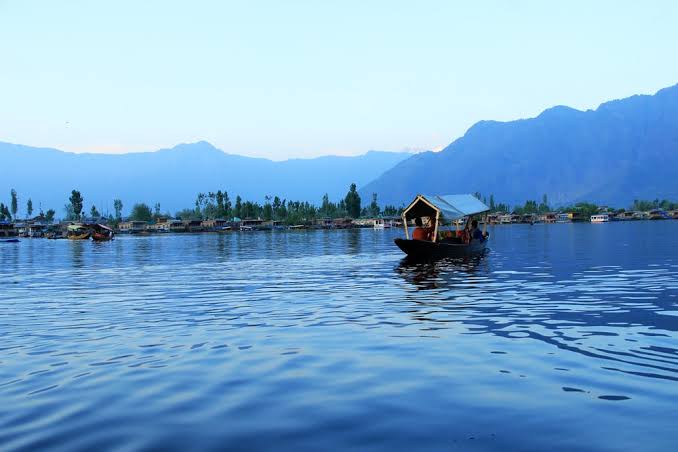It has become an annual ritual for the conservation and management authority of Dal Lake to de-weed and clean up large expanses in an attempt to preserve the decaying water body. The same procedure is repeated every year, despite which the problem exists every following year.
The only change that has been witnessed – in a long timeframe – is the name change of this authority from Lakes and Waterways Development Authority (LAWDA) to Lake Conservation and Management Authority (LCMA).
Dal Lake is located at an average altitude of 1583 meters and is spread over an area of 24.60 sq kms. Of this area, only 15.41 sq.kms are an open expanse with submerged vegetation while eight sq.kms are covered with floating vegetation and cultivated land. The lake receives perennial high-altitude glacial melt and runoff from a catchment spread over more than 350 sq.kms.
It remains a famed lake that is at the heart of Kashmir’s tourism industry. The lake serves as a sprawling host to thousands of tourists who visit the scenic region year after year. Yet the measures taken to safeguard it have been rudimentary and repetitive without much success.
The damaging human interference with the lake’s ecology over the decades and the slow and unscientific conservation efforts have left the lake in a state of continuous degradation. It is not a secret that the entry of sewage and high-nutrient load pose a challenge to Dal Lake’s existing eco-system. The once pristine and blue waters of the lake now appear to be more of a stinking cesspool.
The past officials of the lake’s management authority have acknowledged in various media interviews that the lake faces long-term problems which need long-term solutions. There has been, however, a persistent lack of will to do what is needed.
Take, for example, the requirement of a major sewage treatment of 30 MLD capacity which could prevent entry of sewage from the catchment areas. The large capacity sewage treatment plant has been pending due to lack of money. So with nothing more to do, the officials of the management authority are following the old rule book that has been proven by time to be a failure.
By merely redoing the façade of the lake, by adopting the fancy and easy process of de-weeding the lake, the management authority is merely managing the crisis. The crisis, meanwhile, grows bigger each year.
The entry of sewage has long been described by experts as a major handicap in the conservation of Dal Lake, despite which no significant progress has been made to mitigate this problem. What should have been a priority has been relegated to the backburner and almost forgotten. The experts, who have previously worked on the conservation efforts of the lake, simply rule out the possibility of the success of the lake’s conservation efforts unless the sewage entry is stopped.
The unscientific attempts to seek solutions to the plethora of problems faced by the lake thus lead to newer problems. In recent years, the lake had faced grave danger from the outbreak of lily patches. The lily rhizomes, which are its stems that send out roots and shoots from its nodes, could have proven, and may still prove, deadly for the lake if they are not properly removed which can cause a huge burst of these patches.
The problem faced by the lake is not merely that its ecology is changing and weeds are outgrowing their share in the lake. It is merely a manifestation of the problem. The problem lies somewhere else and there can be no solution till the real problems are identified.
The outgrowth of the weeds are a result of the high-nutrient load that comes with sewage into the lake’s water. While management of the weed should be considered important for aesthetic purposes, the lake needs to breathe fresh to stay alive and healthy.
The lake has suffered extensively during the past decades – and continues to do so – due to increased encroachment, human interference and pollution. If the past models are repeated, the same results will accrue.
Dal Lake’s first conservation report was prepared in 1978, which had provided a detailed description of problems and remedial measures which included proper sewage and waste management. The second conservation report was framed in 1997 and the third in 2000. All these reports have now become redundant as the lake’s ecology has continuously changed over the years and a new ecology has come into being.
The conservation of the new ecology needs a fresh scientific understanding and approach and then only the lake can be saved. The problem of Dal Lake is that those who implemented the conservation measures never properly understood the lake’s complex systems.
A research study in 2007 meant to assess the pollution load of Dal Lake had concluded that different pollutants were contributing towards a “steady degradation of this beautiful lake” as a result of which the lake was “dying an unsung death.”
The study had recommended a need for “very robust action plan based on scientific knowledge of today.”
The first step to conserving the lake will come from scientific experts. An honest and competent scientific approach is the first step in the ladder. The second step should come from the bureaucracy and they should allow a proper and swift implementation of the recommendations of the scientific committee – in letter and spirit.
